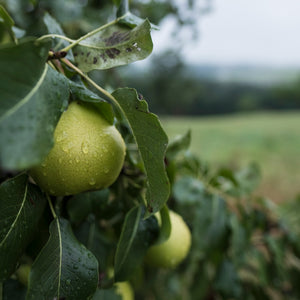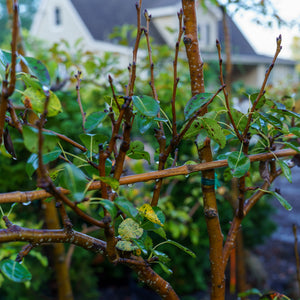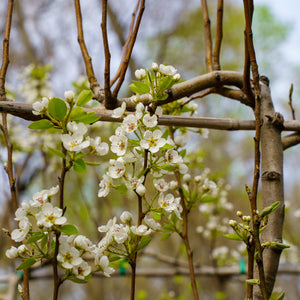The Fruit Tree Guide
Fruit trees are a long-term investment in beauty, biodiversity, and productivity. With proper care, a single tree can yield bushels of fresh, flavorful fruit year after year—whether you're planting apples, peaches, cherries, pears, plums, or apricots. Fruit trees bring seasonal interest, pollinator value, and, ultimately, delicious rewards to home orchards, edible landscapes, and gardens of all sizes.

About
Fruit trees are cultivated for both their ornamental charm and edible harvests. Beloved for their blossoms in spring and colorful fruit in summer and fall, these trees span several genera, including Malus (apples), Prunus (stone fruits like cherries, peaches, plums, and apricots), and Pyrus (pears). Most require thoughtful pruning, sunlight, and care but reward with unmatched flavor and beauty.
Notable cultivars include:
- Apples (Malus spp.): From classic heritage types like 'Baldwin', 'Jonathan', and 'McIntosh' to modern favorites like 'Honeycrisp', 'Fuji', 'Pink Lady', and 'Golden Delicious'. Columnar types like 'Golden Treat' and 'Scarlet Sentinel' suit small spaces.
- Cherries (Prunus avium & Prunus cerasus): Sweet varieties like 'Bing', 'Regina', and 'Black Gold' contrast tart types like 'Montmorency'.
- Peaches (Prunus persica): Dependable producers like 'Redhaven', 'Contender', and 'Reliance' thrive in colder climates. White-fleshed types like 'White Lady' offer fragrant, tender fruit.
- Plums (Prunus salicina & Prunus domestica): Varieties like 'Methley', 'Shiro', 'Bruce', and 'Elephant Heart' are flavorful and productive.
- Apricots (Prunus armeniaca): Cultivars like 'Chinese' and 'Frankthrees' produce early-ripening, golden fruit.
- Pears (Pyrus communis): 'Anjou' and 'Bartlett' are popular standards with buttery texture and sweet flavor.
Each species and cultivar varies in chill requirements, pollination needs, and harvest timing, allowing a staggered harvest across months.
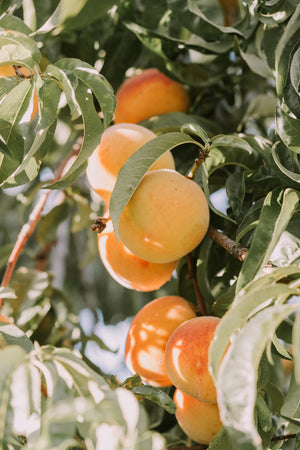
PLANTING
The success of a fruit tree begins with proper planting in the right location and soil:
- USDA Hardiness Zones: Varies by species. Apples, pears, and tart cherries thrive in Zones 4–8; peaches, plums, and apricots generally prefer Zones 5–9.
- Soil: Well-drained loam is ideal. Avoid heavy clay and soggy sites. Test soil pH and amend to 6.0–6.5 where needed.
- Sunlight: Full sun (at least 6–8 hours daily) is essential for flowering and fruit production.
- Spacing: Standard trees: 18–25 feet apart. Semi-dwarf: 12–15 feet apart. Dwarf: 8–10 feet apart.
- Pollination: Many varieties require a compatible second cultivar for cross-pollination—especially apples, pears, and sweet cherries.
- Planting Time: Early spring (bare-root) or early fall (container-grown) for best root establishment.
Dig a hole twice as wide and just as deep as the root ball. Loosen roots, position the graft union above soil level, and backfill with native soil. Water deeply.
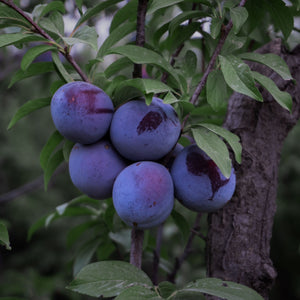
CARE
Fruit trees need regular attention to thrive, including pruning, feeding, watering, and pest management:
- Watering: Keep soil evenly moist, especially during the first two years. Deep water during droughts.
- Fertilizing: Apply a balanced fertilizer (10-10-10) in early spring. Avoid high-nitrogen formulas after midsummer.
- Pruning: Prune annually in late winter or early spring to shape, remove crossing branches, and encourage air circulation.
- Pest & Disease Management: Use dormant oil sprays in winter, monitor for aphids, borers, scab, and blight. Implement organic or integrated pest management if needed.
- Thinning: Remove excess fruit when young to prevent branch breakage and improve fruit size.

HOW TO USE
Fruit trees serve multiple purposes—from food production to landscape structure:
- Home Orchards: Design small-scale orchards with multiple varieties for staggered harvests.
- Edible Landscaping: Use columnar apples or dwarf cherries in foundation beds or along paths.
- Pollinator Gardens: Early spring blossoms support bees and beneficial insects.
- Privacy Screens: Use taller pears or plums for living fences.
- Container Growing: Dwarf varieties can succeed in large pots with proper pruning and support.
Underplant with comfrey, yarrow, or thyme to deter pests and support pollinators.
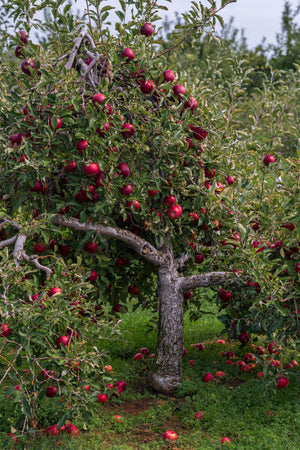
COMMON QUESTIONS
- How to prune fruit trees? Prune annually to shape the canopy, remove dead or crossing branches, and promote light and airflow. Best done in late winter.
- When to fertilize fruit trees? Fertilize in early spring before bud break, and again in midsummer if needed. Avoid late-season nitrogen.
- How to plant fruit trees? Choose a sunny, well-drained site. Dig a wide hole, plant with the graft union above soil, and water thoroughly.
- How to grow fruit trees? Provide full sun, regular pruning, proper watering, and manage pests and diseases for reliable harvests.
- How to keep squirrels out of fruit trees? Use netting, trunk collars, or motion-activated sprinklers. Harvest ripe fruit promptly.
- When to spray fruit trees? Use dormant oil sprays in late winter and follow seasonal schedules for pests/diseases in your region.
- Where do cherry fruit trees grow? Sweet cherries grow best in Zones 5–7; tart cherries tolerate colder Zones 4–8.
- How long does it take an apple tree to bear fruit? Dwarf trees may fruit in 2–3 years; standard trees often take 4–6 years.
- What is the best fertilizer for fruit trees? Use a balanced formula like 10-10-10 or organic blends based on soil test results.
Conclusion
Fruit trees offer beauty, shade, ecological benefits, and—most importantly—an annual harvest of delicious fruit. From the crisp crunch of a homegrown apple to the sweet juiciness of a sun-ripened peach, these trees reward care with abundance. With the right variety selection, planting strategy, and seasonal care, your yard can become a fruitful oasis for years to come.
The Fruit Tree Collection
Sold Out
Sold Out
Sold Out
Sold Out
Sold Out


